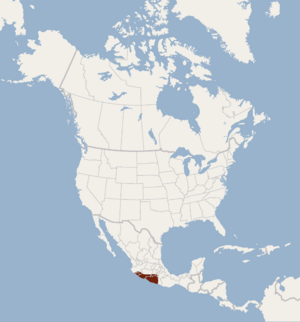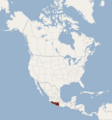Banana bat facts for kids
Quick facts for kids Banana bat |
|
|---|---|
| Conservation status | |
| Scientific classification | |
| Genus: |
Musonycteris
|
| Species: |
harrisoni
|
 |
|
The banana bat (Musonycteris harrisoni) is a special type of bat. It is also known as the trumpet-nosed bat or the Colima long-nosed bat. This bat belongs to the Phyllostomidae family. It is an endangered species, which means there are not many of them left in the wild.
Contents
What Does the Banana Bat Look Like?
The banana bat is a medium-sized bat. Males weigh about 12.6 grams, and females weigh about 10.9 grams. That's about the weight of a few quarters!
This bat has a very long snout, called a rostrum. Its rostrum makes up about half the length of its head. It also has small, round ears and a short tail. Banana bats are usually grayish-brown. Each hair is white at the bottom with a brown tip.
Where Do Banana Bats Live?
Banana bats were first found in a banana grove. These bats live only in Mexico. You can find them mainly in the states of Colima, Michoacán, and Guerrero.
The banana bat has a very small home range. It covers an area of about 20,000 square kilometers. This bat's natural home, or habitat, is dry shrubland in warm, tropical areas. Sadly, their habitat is shrinking. This is a big reason why they are an endangered species. They have been found living at altitudes of over 1,700 meters high.
What Do Banana Bats Eat?
Banana bats are nectarivores. This means they mostly eat nectar from flowers. They drink nectar from both wild plants and plants grown by people.
Some of their favorite plants include Cleome, Pseudobombax, Crataeva, Agave, Helicteres, and Pachycereus pecten-aboriginum. Even though they have a very long snout, they don't only visit flowers with long tubes.
When these bats feed, pollen sticks to their hair. They often eat this pollen. It's an important source of nitrogen, which helps them stay healthy. Many other nectar-eating bats might switch to eating fruits or insects sometimes. But banana bats can't do this because their long jaws make it hard to eat solid food. They need liquid food like nectar.
Studies show that banana bats visit at least 14 different pollen-producing plants. They also visit cultivated banana plants, even though these don't produce pollen.
How Do Banana Bats Behave?
Scientists have studied banana bats to learn about their lives. They found that female bats seem to have babies during the dry season, usually between mid-March and mid-April. They likely reproduce only once a year.
When bats were caught and then released, they usually stayed close to where they were first found. Most were found within 100 meters of their original capture spot.
Even though the amount of nectar available changes throughout the year, banana bats stay in their home area all year long. Some larger bats might travel to find more nectar, but banana bats do not seem to migrate.
Special Abilities of the Banana Bat
Banana bats have some amazing adaptations that help them eat nectar. One cool thing is their hair. The scales on their hairs stick out at an angle. This is unusual because most bats have smooth hair. These special scales help them collect a lot of pollen. The pollen gives them nitrogen and also helps pollinate plants like C. grandiflora.
Another adaptation is their special way of flying. They can hover in the air while feeding on flowers. They also have a super long tongue! It can be up to two-thirds of their body length. This long tongue helps them reach deep into flowers to get all the nectar. One bat's tongue was measured at 76 millimeters (about 3 inches) long!
Images for kids



